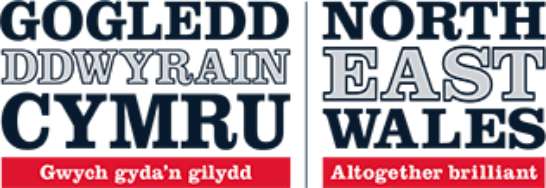Cross County; Rhuthun and Loggerheads (Sir Ddinbych) to Yr Wyddgrug (Mold) in (Sir y Fflint)
Buses 2 and T8
Service 2 (M&H Coaches) takes 56 minutes from Rhuthun to Yr Wyddgrug, as the route detours from the A494 to include Llanarmon-yn-Ial, Grianrhyd and Eryrys.
Meanwhile the T8 (TrawsCymru) sticks doggedly to the A494 and takes only 37 minutes between Rhuthun and Yr Wyddgrug. This is one of the long distance TrawsCymru routes, and runs all the way from Corwen to Chester.
Both services depart from Wynnstay Road in Rhuthun, and Stand 3 at Yr Wyddgrug Bus Station. And both call at Loggerheads Country Park.
Three major roads slice Sir Ddinbych horizontally – the A55 in the north, the A5 in the south and the A494 through the centre. This bus takes that middle route, carving through the Bryniau Clwyd hill chain. Hill country ensconces both Rhuthun and Yr Wyddgrug – both have large livestock markets at their edges. The views from this bus are as spectacular as you’d expect. I hear English conversation at the front, and women behind me discussing knitwear in Cymraeg. For either a gentle or vigorous venture into the hills, Loggerheads Country Park is an ideal gateway.
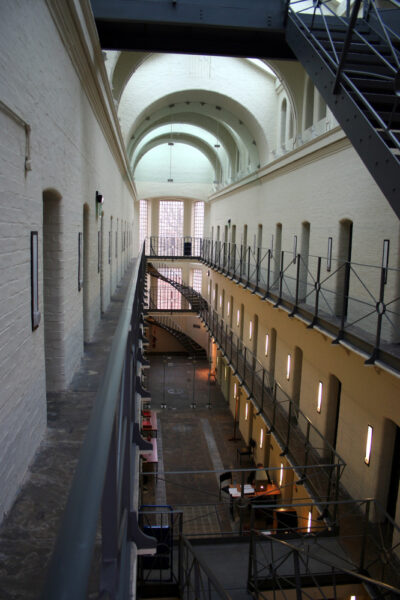
Rhuthun
Was there ever a more bijou settlement? On the rise of a red sandstone hill (which gives the town its name – rhudd meaning red), a medieval medley of timber-framed buildings radiate from St Peter’s Square along higgledy streets. The Wayfarer Wool shop is wonderfully wonky. Teashops abound; Becws Islwyn, Chatwins, Teacups, as do small shops like Rhoda’s Sweets and Tobacco, Ruthin Wholefoods and Trefor Jones Menswear. Meanwhile Stan is chopping lamb in John Jones & Son Family Butchers, Grocers and Fishmongers, carefully removing the kidneys. “It’s time I retired” he says cheerfully. “Nice to see you, cariad.”
Rhuthun is so history-rich and aesthetic, it’s hard to know where to start. It’s almost a relief I’m not here on a Thursday, Friday or Saturday, when you can apparently, buy woodcrafts, jewellery and honey made by local producers at the Market Hall near the bus stop. That I am visiting out of season, and can’t be distracted by Nantclwyd-y-dre fifteenth-century house and gardens. And Rhuthun Gaol, active from 1654 to 1916, whose courtyard looks like a film-set (the cowboys having just left). Afon Clwyd runs alluringly behind its walls. How many prisoners did it taunt with the music of its watery freedom? The river dances beneath pollarded birch. And leads me to the Craft Centre.
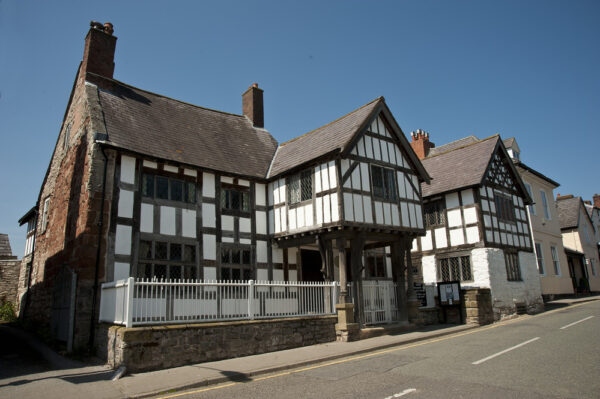
Rhuthun Craft Centre
This modern purpose-built gallery is spacious and light. You can’t help softening your footsteps, speaking in whispers. When I visit, the main studio is full of ceramic pots. Small ones on shelves, large ones in the middle. As if I’ve landed in the Plain of Jars. This is Adam Buick’s beautiful exhibition; Grounding. Each pot is a conversation with the landscape. Some he leaves in the rain before firing, or to weather in windblown sand. Others he films dissolving in rock pools.
I leave the gallery in an artistic mood, so am pleased that an Art Trail conceived back in 2014 – in a thoroughly successful attempt to connect the Craft Centre with the town – is still going strong. Two intertwining trails, really. One, consisting of tiny human metal figures atop buildings, encourages you to appreciate the glorious roof-scape. The other is a series of ‘spyholes’ set into walls.
The spyholes are boxes you peep into, to see an illuminated illustrated legend or period of local history. A cenotaph by the town war memorial. A Franciscan monk (the last person to be hung, drawn and quartered, in 1679) outside the gaol. This is tiny art on a big scale, an intimate insight into another world. Subtle and locally relevant, it is the most delightful public art I have ever encountered. “Are you looking for the little people?” a bearded man asks me, pointing out one on the Market Hall roof. Two ladies catch me squinting at an execution of the priest. “Well that’s added an extra dimension to our shopping trip” they beam. “We only came here for embroidery silks.”
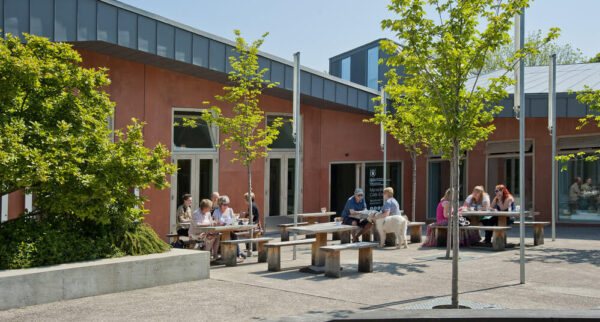
Rhuthun Castle
I ended up in the castle grounds one hot August evening between buses, expecting to be evicted. Granted, I would have been much more intimidated by the castle back in the 13th century – when it was freshly built by tyrannous Edward I, boasting curtain walls and a pentagonal moated court. Despite being largely ruined now, its ostentatious gates, and particularly the signs for Castle Hotel and Spa are still daunting enough for a groundling like me. But the gates are open. It turns out everyone is welcome to drift around the gorgeous landscaped gardens, and drink in Tafarn Y Ddraig – residents and non-residents alike.
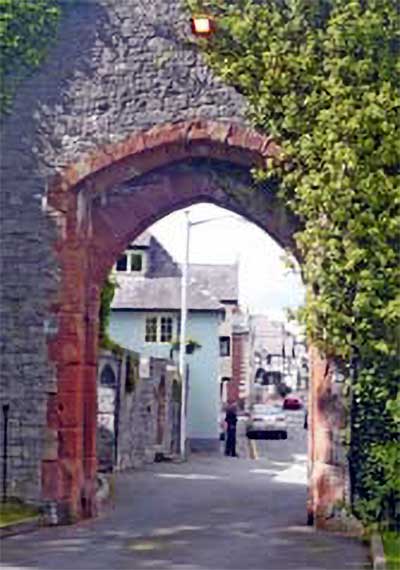
Rhuthun Courthouse
Something about Rhuthun keeps leading me back up the sandstone hill, to the centre. Golden leaves are whirling outside St Peter’s Church. The medieval streets dropping away in all directions are a wonderful sight and the buildings are pleasing to contemplate. “That one next to Wetherspoon is called the Seven Eyes of Rhuthun” says Roger Edwards, who as a volunteer at the Old Court House (now a community centre) has been looking out for visitors like me, from his spot on the bench. “It’s in a Dutch style because it was built by a local tradesman who did a lot of business with Holland.”
“Sutmae Mr Edwards!” Roger is an ex-teacher, and greeted by almost everyone who passes. One ex-pupil is Alun, retired himself now, with, despite chemotherapy, a shock of hair we all agree is a thing of mystery. “Rhai o’r bysiau fynd i’r Caer” says Alun. “Some of the buses go to Chester with Welsh on the front. Well your average person in Chester is not going to know what the hell a ‘Gorsaf’ (station) is are they?”
Roger gives me a tour of the timber-framed courthouse. “We had a dendrochronology survey” he says, “so we know that this beam was hacked from the tree in 1427.” The jail cells became bank vaults – it was a bank till six years ago.
Roger reveals that he features in one of the spyholes – the one depicting a boy surrounded by sheep. “Because I can remember drovers coming to town” he says. We go back outside to the bench, which overlooks the roundabout at the centre of town. Roger says the roundabout has not been there too many years, and now they want to remove it, though he’s not sure why. “I can remember before they put it there. There was nothing to control the traffic. We used to sit where we’re sitting now, with our transistor radios, and watch the cars crashing.”
If you have time to wait for the bus, I highly recommend the library, which in Rhuthun – as elsewhere in Sir Ddinbych, is open and welcoming, staffed by helpful people.
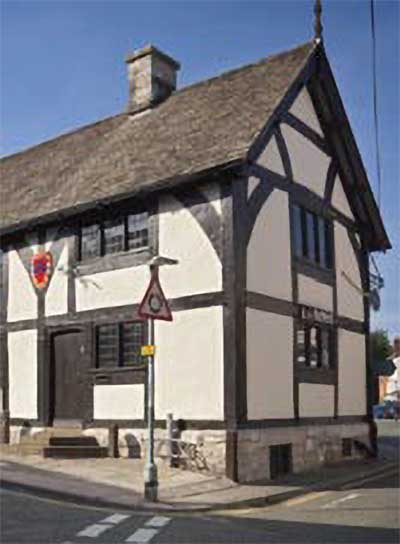
Loggerheads Country Park
The bus drops you outside We Three Loggerheads pub – but more of this later, it being an excellent place to wait for the return or onward journey. Meanwhile, the entrance to Loggerheads Country Park is just across the road.
Loggerheads Country Park
The park really does have something for everyone. If you are merely in the mood for a peaceful pit-stop, there is no need to stray from the visitor centre, café and gift shop on the gentle banks of Afon Alyn. If you fancy a gentle stroll, you have accessible paths and a lush green – it’s a great place for picnics, young families and dog-walkers.
And from here you can hike up Moel Famau, or further into Bryniau Clwydian, that spectacular hill chain running from north to south between Sir Ddinbych and Sir y Fflint. Or merely stick to the easy walks along the lovely Alyn, shallow and brown, and up to Devil’s Gorge where two limestone walls meet. Limestone crags overlook the park, adding a delicious drama. Limestone underpins it too, influencing the flower-rich grasslands and leafy mixed ash woodlands. Plants surviving on the crags include bloody cranesbill, rockrose, and wild thyme, which in turn support butterflies and moths. These are crags which acclaimed artist Richard Wilson – often said to be the father of British Landscapes – used to paint.
At the visitor centre, there’s the chunk-clunk and sloosh of the restored water wheel, as it turns on its cogs. In the early nineteenth century, corn was ground at Pentre Mill, which also powered a saw-mill. It is hard to imagine the dust and grind among all this green serenity. Harder still to imagine the lead mining and quarrying that took place here. A salutary reminder of how landscapes are always changing.
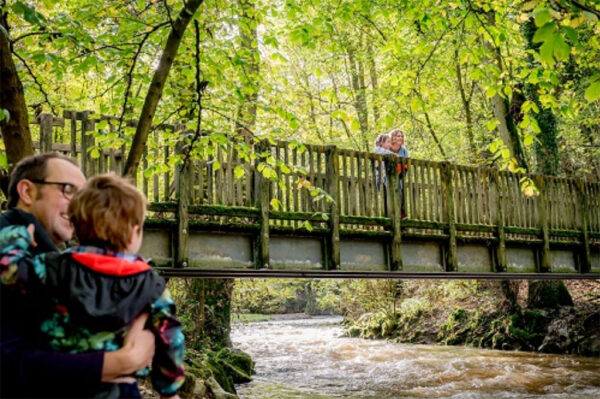
We Three Loggerheads
Open every day, this restored seventeenth-century coaching inn is a great place to wait for the bus, and a nice blend of comfort and antique wobble. Like most places I have been to in Sir Ddinbych, I happen immediately upon a friendly local with stories to tell. “I’m just here for a beer then I’m home” says Paul Maguire. “I live up there, in the sticks.” He shows me the old pub sign, now framed in the dining area, and signed by the artist Richard Wilson, who is buried round the back of the church in Yr Wyddgrug. “Story was he painted it to pay off a debt” says Paul, “but it turns out not to be true. Someone else painted it.” Either way, it’s a good story, and a very good pub.
Yr Wyddgrug (Mold)
I finish my journey with a brief cross-border sojourn into Yr Wyddgrug in Sir y Fflint. I have only two hours but that’s enough to remind me Yr Wyddgrug is a spirited place. I’ve been here on sunny market days (Wednesdays and Saturdays) when the whole town is buzzing, strolling, chatting, and snacking among colourful stalls.
Today is not one of those days. The livestock market next to the bus station is not open either. “Mondays and Fridays” says a man hosing down a livestock lorry. “Yes and a hell of a day it is.”
The sky is grey and the wind is gusting. Days like these excite me. I am drawn to the Church of St Mary the Virgin, lofty on its perch above town. Inside it is warm and wide and the silence is soft. I can hear the curate creaking in his chair. A parade of stained glass windows grant the interior an astonishing kaleidoscope of colour to match the cherry leaves whirling outside.
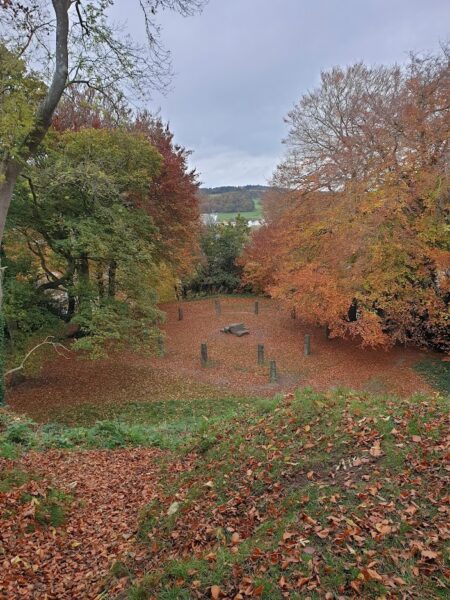
Bailey Hill
Meanwhile at Bailey Hill, the wind is tossing about the yellow leaves of a huge ancient sweet chestnut. Bailey Hill is what remains of a huge motte and bailey castle, whose earthworks were built into the edge of a glacial esker. The castle was probably constructed from both timber and masonry, early in the Norman Conquest. Now the site is a space of wind and trees. Pigeons flap among them. Beechnuts crunch underfoot. Jackdaws caw and squirrels scurry.
Yr Wyddgrug has an excellent bookshop and library. It is a pulsating town and a good place to be hungry. Choose from the Hungry Cow, The Fat Boar, Pound Bakery… I sip good soup in the window of The Gathering, (which refers one assumes, to when the sheep are brought down from the hills), watching the world go by. And then I jump back on the bus.
